
This Viking Age runestone, listed under Rundata as runic inscription U 489, was originally located in Morby, Uppland, Sweden, and is a memorial to a woman.
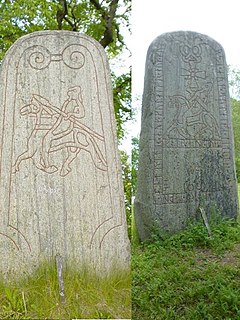
U 678 is the Rundata catalog number for a Viking Age image stone with a runic inscription located in Skokloster, Uppland, Sweden.

The Varangian Runestones are runestones in Scandinavia that mention voyages to the East (Austr) or the Eastern route (Austrvegr), or to more specific eastern locations such as Garðaríki.
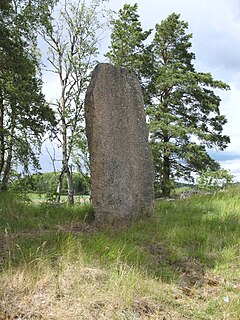
The Gällsta Runestones from the 11th century commemorate four generations of the same family in Viking Age Sweden. There are three runestones and a raised stone which is only inscribed with a cross. The runestones are located at the northern outskirts of Stockholm, just northwest of the lake Vallentunasjön, around which is found the world's greatest concentration of runestones. All the Gällsta Runestones are attributed to Öpir, the most productive of all the old runemasters.
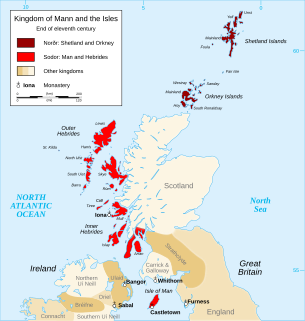
The Manx runestones were made by the Norse population on the Isle of Man during the Viking Age, mostly in the 10th century. Despite its small size, the Isle of Man stands out with many Viking Age runestones, in 1983 numbering as many as 26 surviving stones, which can be compared to 33 in all of Norway. So many of them may appear on the Isle of Man because of the merging of the immigrant Norse runestone tradition with the local Celtic tradition of raising high crosses.

Södermanland Runic Inscription 84 or Sö 84 is the Rundata designation for a runic inscription on a Viking Age memorial runestone located in Tumbo, Södermanland County, Sweden, and in the historic province of Södermanland.

Uppland Runic Inscription 308 or U 308 is the Rundata catalog designation for a memorial runestone that is located in Ekeby, Stockholm County, Sweden, which was in the historic province of Uppland. While the tradition of carving inscriptions into boulders began in the 4th century and lasted into the 12th century, most runestones date from the late Viking Age.

This runic inscription, designated as U 448 in the Rundata catalog, is on a Viking Age memorial runestone located in Harg, which is about 4 kilometers north of Märsta, Stockholm County, Sweden, which was in the historic province of Uppland.
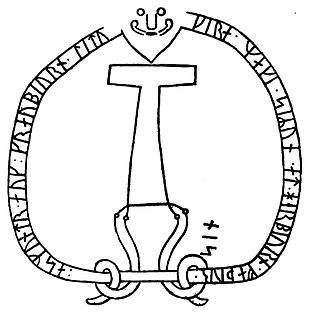
Sö 86 is the Rundata catalog number for a Viking Age memorial runic inscription located in Åby, which is about one kilometer north of Ålberga, Södermanland County, Sweden, and in the historic province of Södermanland. The inscription features a depiction of the hammer of the Norse pagan god Thor named Mjöllnir and a facial mask.

This runic inscription, designated as U Fv1948;168 in the Rundata catalog, is on a Viking Age memorial runestone to two sons that is located in Alsike, Uppsala County, Sweden, which is in the historic province of Uppland.
The Lilla Vilunda runestones are three Viking Age memorial runestones that were erected by members of the same family and which are located at Lilla Vilunda in Upplands Väsby, Stockholm County, Sweden, and in the historic province of Uppland.
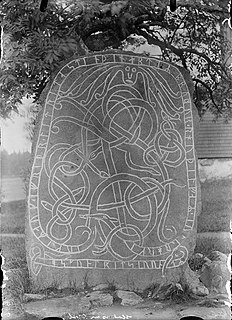
Uppland Runic Inscription 824 is the Rundata catalog number for a Viking Age memorial runestone located at Holms, which is about eight kilometers east of Örsundsbro, Uppsala County, Sweden, and in the historic province of Uppland. The inscription features a facial mask and a bind rune in the text.

Uppland Runic Inscription 181 or U 181 is the Rundata catalog number for a Viking Age memorial runestone located at Össeby-Garn, which is about one kilometer east of Karby, Uppsala County, Sweden.

Uppland Runic Inscription 993 or U 993 is the Rundata catalog number for a Viking Age memorial runestone located in Brunnby, which is one kilometer west of Gunsta, Uppsala County, Sweden, which was part of the historical province of Uppland.
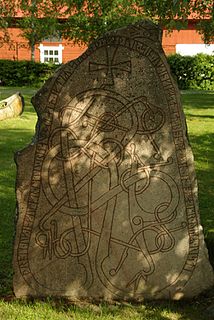
Uppland Runic Inscription 485 or U 485 is the Rundata catalog number for a Viking Age memorial runestone that is located in Marma, which is about six kilometers northeast of Knivsta, Uppsala County, Sweden, which was in the historic province of Uppland.

The Kyrkogården Runestones are three Viking Age memorial runestones located at the cemetery of St. Mary's Church in Sigtuna, Stockholm County, Sweden, in the historic province of Uppland. One of the runic inscriptions documents the existence of a Viking Age mercantile guild in Sweden.

Uppland Runic Inscription Fv1953;263 or U Fv1953;263 is the Rundata catalog listing for a Viking Age memorial runestone that was discovered at Helenelund, which is in Sollentuna, Stockholm County, Sweden, which was in the historic province of Uppland.
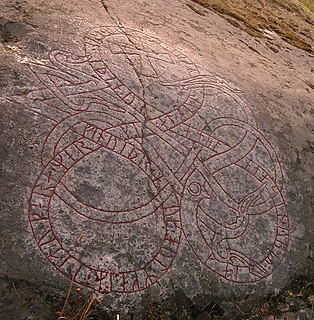
Uppland Runic Inscription 210 or U 210 is the Rundata catalog listing for a Viking Age memorial runic inscription which is carved on a rock-face that is located in Åsta, which is three kilometers east of Vallentuna, Stockholm County, Sweden, and in the historic province of Uppland. The inscription is signed by the runemaster Öpir.

Uppland Runic Inscription 541 or U 541 is the Rundata catalog listing for a Viking Age memorial runestone which is located at the Husby-Sjuhundra church, which is five kilometers west of Norrtälje, Stockholm County, Sweden, and in the historic province of Uppland. The inscription is signed by the runemaster Öpir.

The Bolsta Runestones are two Viking Age memorial runestones and two fragments of a third that are located in Bolsta, which is on the east edge of Uppsala, Uppsala County, Sweden, and in the historic province of Uppland. One runestone is signed by the runemaster with the normalized name of Åsmund Kåresson and the other by the runemaster named Öpir.



















